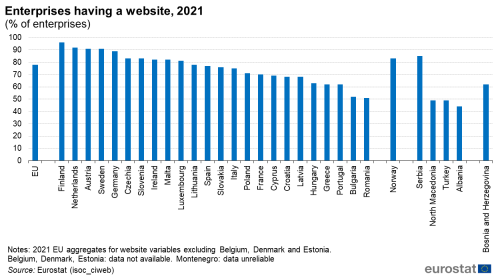E-business integration
Data extracted in May 2022.
Planned article update: 16 May 2024.
Highlights
In 2021, 38% of EU enterprises used Enterprise resource planning (ERP) software applications.
In 2021, the percentage of EU enterprises using Enterprise resource planning (ERP) ranged from 33% for small enterprises to 81% for large enterprises.
Enterprises having ERP (enterprise resource planning) software package in 2021
ICT for e-business integration
This article presents recent statistics on the information and communication technologies (ICT) used by enterprises in the European Union (EU). ICT has fast become an integral part of enterprise functioning and its extensive and intensive use, combined with new ways of using the internet efficiently, is decisive for the way that enterprises run their business, organise internal communication, share information with business partners and communicate with customers.
In this context, the main results of the 2021 survey on EU enterprises' presence on the internet and the use of ERP and CRM software applications are presented in this article.
Full article
Adoption of e-business: highlights
In 2021, 78 % of EU enterprises reported having a website, 38 % used enterprise resource planning (ERP) software applications and 35 % used customer relationship management (CRM) software.
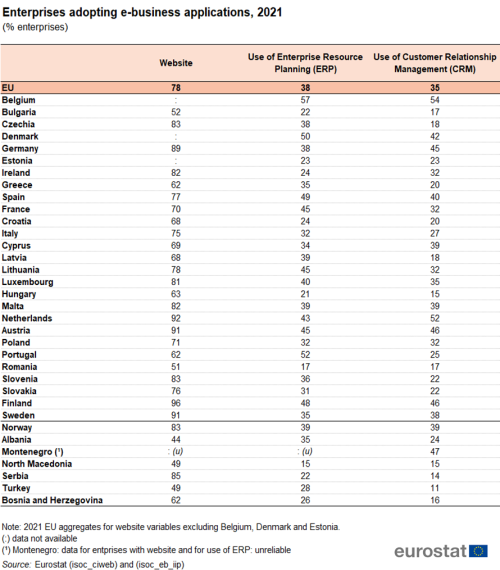
(% enterprises)
Source: Eurostat (isoc_ciweb) and (isoc_eb_iip)
As shown in Figure 1, the share of enterprises with a website (78 %) grew slightly in 2021 compared with 2019 (77 %). The use of ERP software and the share of enterprises using CRM software both recorded an increase by 2 percentage points (pp).
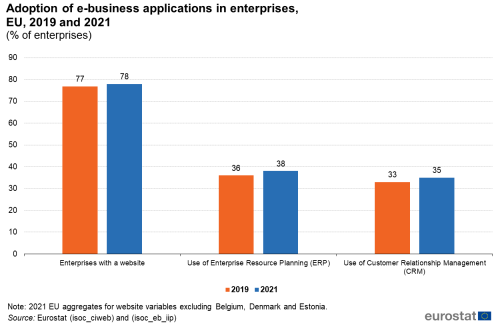
(% of enterprises)
Source: Eurostat (isoc_ciweb) and (isoc_eb_iip)
The adoption of e-business applications varies among enterprise size classes. Figure 2 shows that the gap between small and large enterprises is reportedly bigger for those using the ERP or CRM software applications than for those having a website. The percentage of enterprises with a website ranged from 75 % for small enterprises to 94 % for large enterprises, but from 33 % to 81 % respectively for those using ERP software and from 31 % to 65 % for the enterprises using CRM software.
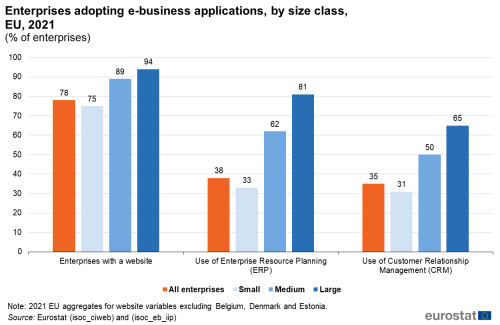
(% of enterprises)
Source: Eurostat (isoc_ciweb) and (isoc_eb_iip)
Enterprises' presence on the internet
Use of websites is still slightly growing
Enterprises consider it important to be visible on the internet. Consequently, enterprises’ websites increasingly offer various functionalities, such as online ordering, product catalogues and information, order tracking, customisation of products, links to social media etc. Importantly, the use of a website involves a more active role than just having an internet connection. In 2021, 78 % of enterprises reported having a website. As shown in Figure 1, a slight increase can be observed compared to 2019 (by 1 percentage point). The shares of enterprises reporting to have a website ranged from over 90 % in Finland, the Netherlands, Austria and Sweden to less than 60 % in Bulgaria and Romania (Figure 3).
Functionalities of enterprises' websites
Description of goods or services and price information was the most common functionality of enterprises' websites
As shown in Figure 4, more than three in five (62 %) of the enterprises in the EU used their website to provide description of goods or services and price information. For more than a third of enterprises (41 %) the purpose of the website was also to establish a link to the their social media profiles. This functionality was particularly significant for large enterprises, where 71 % reported that their website provides reference to their social media presence, compared with 38 % for small enterprises. More than one fifth (21 %) of EU enterprises used their website as a direct sales channel and offered the functionality for online ordering, reservation or booking. The possibility for order tracking was provided on the websites of 10 % of enterprises.
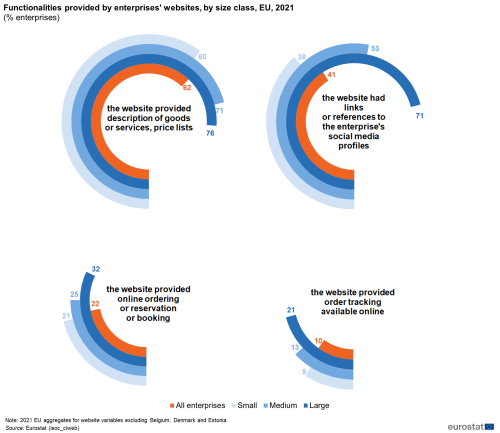
(% of enterprises)
Source: Eurostat (isoc_ciweb)
Enterprise resource planning (ERP)
More than one in three enterprises uses enterprise resource planning software applications
Internal e-business integration refers to sharing information electronically and automatically between different business functions within an enterprise as opposed to external integration, in which other business partners are involved. Internal integration potentially streamlines and boosts the efficiency of an enterprise. Integration is implemented in various forms. One of them is data linking between various software applications, using a common database. The use of a single modular software application, enterprise resource planning (ERP), is another commonly-used alternative. ERP software applications aim to facilitate the flow of information and offer the potential to integrate internal and external management of information across several functions of an enterprise. A characteristic of ERP is that it is delivered in ‘modules’ that typically integrate processes relevant to planning, purchases, marketing, sales, customer relationship, finance and human resources. The percentage of EU enterprises that used ERP software applications reached 38 % in 2021, an increase by 2 pp compared with 2019 (Figure 1). A comparison across the different economic sectors shows that, in 2021, more than half of enterprises in information and communication sector used ERP (54 %). Shares of enterprises using ERP higher than 40 % were registered also in manufacturing (49 %), in electricity, gas, steam and air conditioning (48 %), in wholesale and retail trade (46 %) and in real estate activities (44 %). The lowest rates of adoption of ERP software were recorded in accommodation (28 %) and in construction (26 %) (Figure 5).
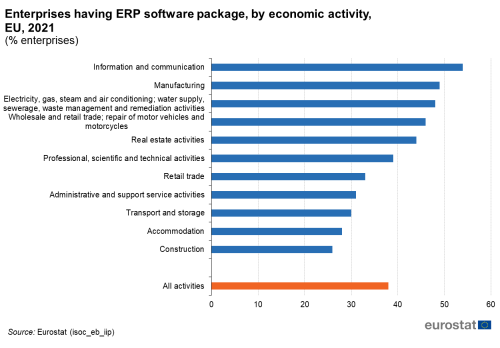
(% enterprises)
Source: Eurostat (isoc_eb_iip)
In 2021, more than half of the enterprises in Belgium, Portugal and Denmark used an ERP software to share information between different functional areas. On the other hand, ERP software was used by 17 % of enterprises in Romania, 21 % in Hungary and 22 % in Bulgaria (Figure 6).
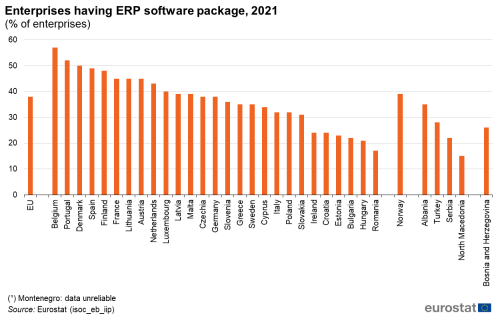
(% of enterprises)
Source: Eurostat (isoc_eb_iip)
Customer relationship management (CRM)
Almost one in three enterprises uses operational customer relationship management software
Enterprises streamline their marketing efforts and target their customers to maximise business potential. For this specific purpose, they use software applications for managing information about their customers, i.e. customer relationship management (CRM) applications. It is believed that the adoption of CRM increases marketing and sales performance by improving customer service and customer relationships. Enhancements come, for instance, from providing user-friendly mechanisms for receiving complaints, identifying potential problems before they occur, in general, by facilitating communication with the customer and by anticipating customer preferences. These technology-enabled improvements lead to long-term customer satisfaction and can ensure increased customer loyalty, decreasing marketing costs and increasing sales. The share of EU enterprises using CRM stood at 35 % and recorded a slight increase by 2 percentage points in 2021 compared to 2019 (Figure 1).
The use of CRM software applications to capture, store and make available information about the enterprise's customers to other business functions is described as operational CRM. As shown in Figure 7, in 2021 some 34 % of EU enterprises reported using operational CRM. Furthermore, a CRM software application can be used to analyse customer information to identify patterns of customer preferences and behaviour (analytical CRM). This information is essentially used for marketing purposes, such as sales promotions that are effective in creating interest in a product or for optimising market penetration through the use of alternative distribution channels. In 2021, some 19 % of EU enterprises used analytical CRM for such sophisticated purposes. The share registered for large enterprises (46 %) was almost three times higher than the share recorded for small enterprises (17 %) (Figure 7).
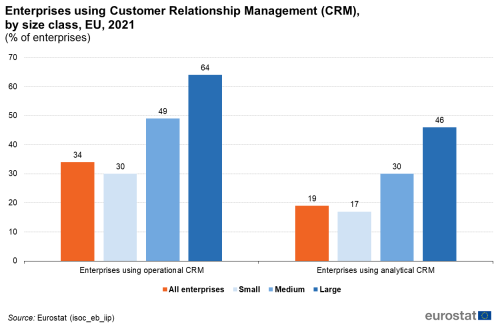
(% of enterprises)
Source: Eurostat (isoc_eb_iip)
As regards the activity of enterprises, in 2021 the adoption levels of analytical CRM were much lower than those of operational CRM. The smallest difference between the shares of enterprises using analytical CRM and operational CRM was recorded in both the accommodation sector and the retail trade sector (36 % to 44 % and 21 % to 29 % respectively, see Figure 8).
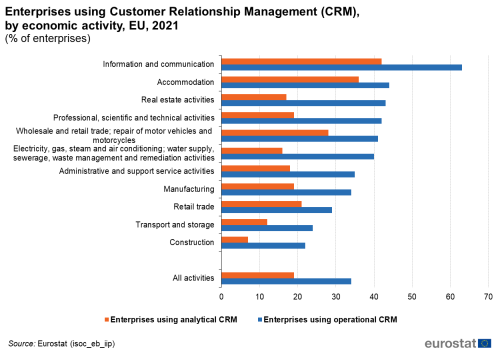
(% of enterprises)
Source: Eurostat (isoc_eb_iip)
Figure 9 presents the adoption levels of analytical CRM and operational CRM in the Member States. The highest shares of enterprises using operational CRM were recorded in Belgium (53 %), the Netherlands (51 %) and Austria (46 %). Analytical CRM was used most in Malta (31 %), Spain (29 %) and Finland (28 %).
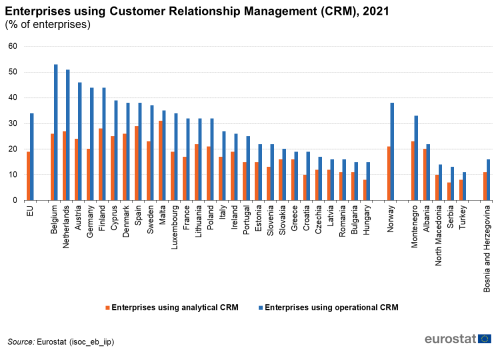
(% of enterprises)
Source: Eurostat (isoc_eb_iip)
Source data for tables and graphs
Data sources
Data presented in this article are based on the results of the 2021 survey on 'ICT usage and e-commerce in enterprises'. Statistics were obtained from enterprise surveys conducted by National Statistical Authorities in the first months of each year. The survey's reference period is the current situation of the survey period or for some questions the preceding calendar year.
In 2021, 148 000 of the 1.5 million enterprises in the EU were surveyed. Of the 1.5 million enterprises, approximately 83 % were small enterprises (10-49 employees and self-employed persons), 14 % medium (50-249 employees and self-employed persons) and 3 % large (250 or more employees and self-employed persons).
Data in some tables are shown as ‘:’ and refer to data that are unavailable, unreliable or confidential. Unreliable data are included in the calculation of European aggregates.
The observation statistical unit is the enterprise, as defined in Council Regulation 696/93 of 15 March 1993. The survey covers enterprises with at least 10 employees and self-employed persons. Economic activities correspond to the classification NACE Revision 2. The sectors covered are manufacturing, electricity, gas and steam, water supply, construction, wholesale and retail trades, repair of motor vehicles and motorcycles, transportation and storage, accommodation and food service activities, information and communication, real estate, professional, scientific and technical activities, administrative and support activities and repair of computers and communication equipment. Enterprises are broken down by size: small (10-49 employees and self-employed persons), medium (50-249 employees and self-employed persons) and large enterprises (250 or more employees and self-employed persons).
Context
ICT has fast become an integral part of enterprise functioning and its extensive and intensive use, combined with new ways of accessing and using the internet efficiently is decisive for the way that enterprises run their business, organise internal communication, share information with business partners and communicate with customers. In this context enterprises are particularly concerned with their presence on the internet via their websites and use increasingly ERP and CRM software applications for the organisation of their internal business processes.
Digital transformation is high on the European policy agenda, with making Europe fit for the digital age and empowering its citizens and businesses with a new generation of technologies being one of the main political priorities of the European Commission for the coming years. In 2021, the Digital Compass for the EU's Digital Decade (COM(2021)118 final), set the EU’s digital targets for 2030, evolving around four cardinal points: skills, digital transformation of businesses, secure and sustainable digital infrastructures, and digitalization of public services.
Direct access to
- E-commerce statistics
- ICT specialists - statistics on hard-to-fill vacancies in enterprises
- Internet advertising of businesses - statistics on usage of ads
- ICT security in enterprises
- Social media - statistics on the use by enterprises
- Cloud computing - statistics on the use by enterprises
- Digital economy and society statistics - enterprises
ICT usage in enterprises (isoc_e)
- Summary of EU aggregates (isoc_ci_eu_en2)
- Websites and functionalities (isoc_ciweb)
- E-business (isoc_eb)
- Integration of internal processes (isoc_eb_iip)
- ICT usage and e-commerce in enterprises (ESMS metadata file - isoc_e_esms)
- Regulation (EU) 2019/2152 of the European Parliament and of the Council of 27 November 2019 on European business statistics
- Regulation (EC) No 808/2004 of the European Parliament and of the Council of 21 April 2004 concerning Community statistics on the information society
- Regulation (EC) No 960/2008 of 30 September 2008 implementing Regulation (EC) No 808/2004 concerning Community statistics on the information society
- Regulation (EC) No 1023/2009 of 29 October 2009 implementing Regulation (EC) No 808/2004 concerning Community statistics on the information society
- Regulation (EU) No 821/2010 of 17 September 2010 implementing Regulation (EC) No 808/2004 concerning Community statistics on the information society
- Regulation (EU) No 937/2011 of 21 September 2011 implementing Regulation (EC) No 808/2004 concerning Community statistics on the information society
- Regulation (EU) No 1083/2012 of 19 November 2012 implementing Regulation (EC) No 808/2004 concerning Community statistics on the information society
- Regulation (EU) No 859/2013 of 5 September 2013 implementing Regulation (EC) No 808/2004 concerning Community statistics on the information society
- Regulation (EU) No 1196/2014 of 30 October 2014 implementing Regulation (EC) No 808/2004 concerning Community statistics on the information society
- Regulation (EU) 2015/2003 of 10 November 2015 implementing Regulation (EC) No 808/2004 concerning Community statistics on the information society
- Regulation (EU) 2016/2015 of 17 November 2016 implementing Regulation (EC) No 808/2004 concerning Community statistics on the information society
- Regulation (EU) 2017/1515 of 31 August 2017 implementing Regulation (EC) No 808/2004 concerning Community statistics on the information society
- Regulation (EU) 2018/1798 of 21 November 2018 implementing Regulation (EC) No 808/2004 of the European Parliament and of the Council concerning Community statistics on the information society for the reference year 2019
- Regulation (EU) 2019/1910 of 7 November 2019 implementing Regulation (EC) No 808/2004 of the European Parliament and of the Council concerning Community statistics on the information society for reference year 2020
- Regulation (EU) 2020/1030 of 15 July 2020 laying down the technical specifications of data requirements for the topic ‘ICT usage and e-commerce’ for the reference year 2021, pursuant to Regulation (EU) 2019/2152 of the European Parliament and of the Council
- Regulation (EU) 2021/1190 of 15 July 2021 laying down the technical specifications of data requirements for the topic ‘ICT usage and e-commerce’ for the reference year 2022 pursuant to Regulation (EU) 2019/2152 of the European Parliament and of the Council
